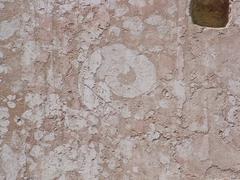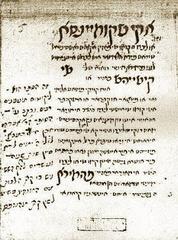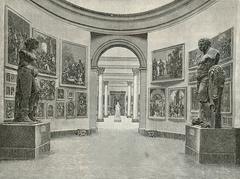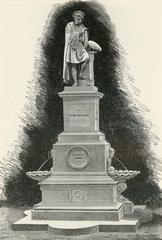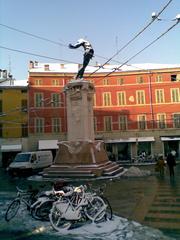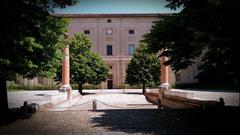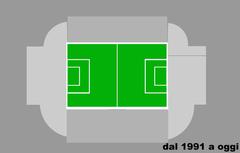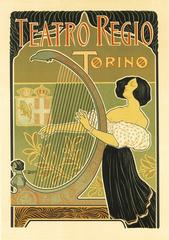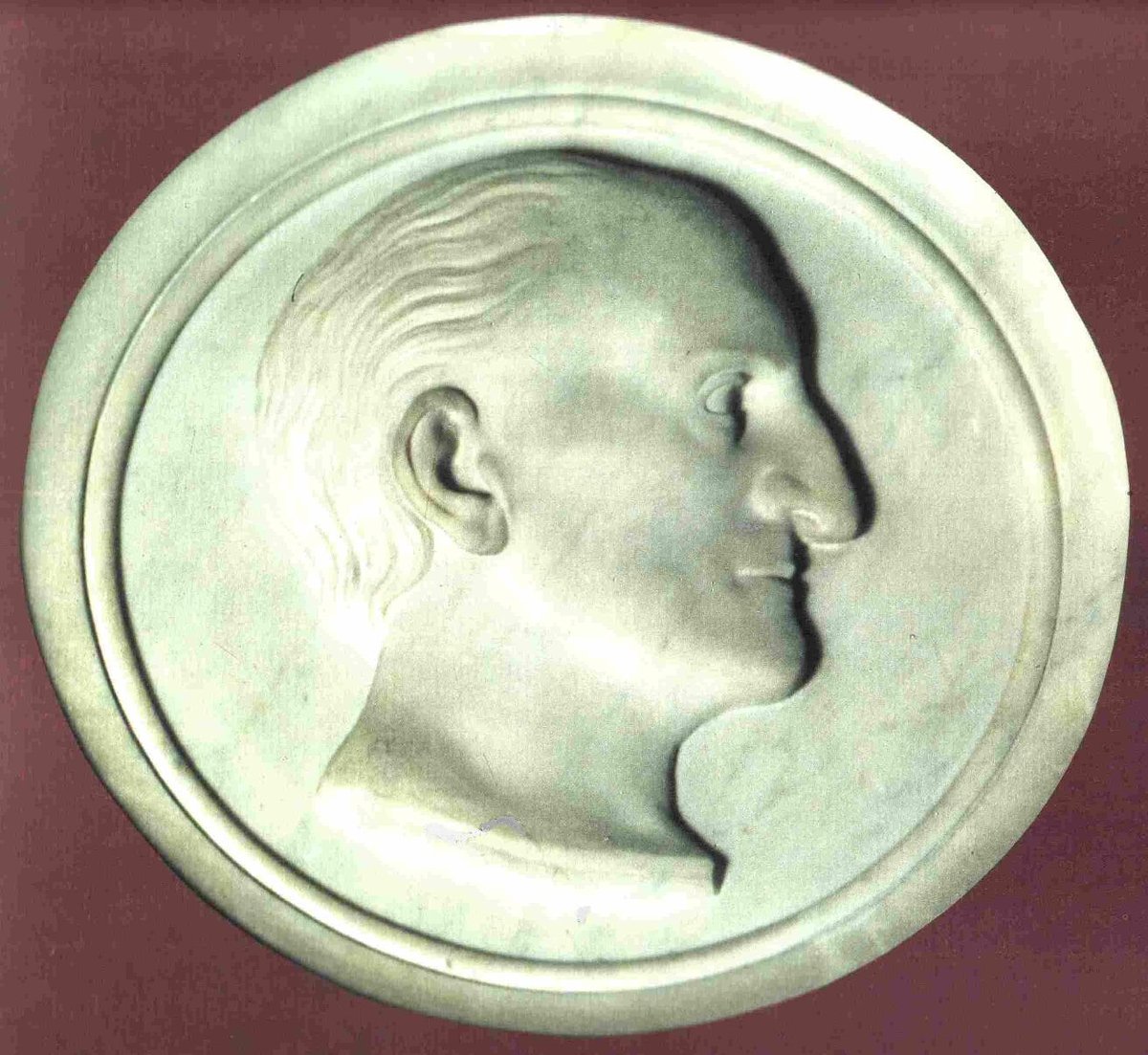
San Giovanni Evangelista Parma: Comprehensive Guide to Visiting Hours, Tickets, and Historical Highlights
Date: 15/06/2025
Introduction: Discovering San Giovanni Evangelista
San Giovanni Evangelista in Parma is an exceptional treasure of Italian religious, cultural, and artistic heritage. Founded as a Benedictine monastery in the 10th century, it has become a magnet for visitors seeking Renaissance art, spiritual contemplation, and a deep dive into Italy’s layered history. The church’s evolution—from its Romanesque foundations through Renaissance grandeur and Baroque embellishments—mirrors the broader narrative of Parma’s historic transformation.
Among its many highlights are the legendary dome frescoes by Antonio Allegri (Correggio), renowned for their illusionistic brilliance and theological symbolism. Early works by Parmigianino and other Renaissance masters add further richness. The complex’s cloisters and manuscript library underscore its ongoing cultural and intellectual significance.
This guide provides all essential information for visitors, including up-to-date details on opening hours, ticketing, accessibility, artistic and architectural highlights, and practical tips for an unforgettable visit to San Giovanni Evangelista, Parma. For further planning resources, consult official sources such as Visit Parma, Emilia Delizia, and Correggio500.
Quick Reference: Contents
- Introduction
- Visiting Hours and Ticket Information
- Accessibility
- Location and Nearby Attractions
- Historical Overview
- Spiritual and Artistic Legacy
- Architectural Highlights
- Artistic Treasures
- Practical Tips and Visitor Information
- Frequently Asked Questions (FAQ)
- Visual & Interactive Content
- Conclusion and Recommendations
- Sources
Visiting Hours and Ticket Information
- Church Opening Hours: Daily, 08:30–12:00 and 15:30–19:30.
- Monastery (Library, Cloisters): Monday–Saturday, 09:00–12:00 (closed Thursdays).
- Admission: Entry to the church is free; special exhibitions and sites (e.g., Camera di San Paolo) require a ticket (e.g., €8–€12 for combined Correggio500 access as of 2025).
- Tickets: Purchase on-site or online via the official Parma tourism website. Advance booking is recommended, especially during peak times and special exhibitions.
- Guided Tours: Available daily, offering in-depth insights into the church’s history and art. Booking in advance is advisable during popular periods.
Accessibility
San Giovanni Evangelista is committed to accessibility:
- Main entrances have ramps for wheelchair users.
- Most primary areas are accessible, though some historic sections (like the medieval library) may have limited access due to narrow staircases.
- Assistance is available upon request; contact the site in advance for specific needs.
Location and Nearby Attractions
- Address: Centrally located in Parma’s historic core, immediately behind the Cathedral.
- Nearby Sights: Parma Cathedral, Baptistery, Pilotta Palace, Teatro Regio, and Monastero di San Paolo are all within easy walking distance, making the church an ideal starting point for exploring Parma’s cultural landscape.
Historical Overview
Early Foundations and Medieval Origins
Founded in the 10th century, the Benedictine monastery of San Giovanni Evangelista became a pivotal center of religious and intellectual life in Parma. The original church was devastated by fire in 1477, but the monastery’s scriptorium was renowned for producing illuminated manuscripts, some of which remain in the library today (Wikipedia).
Renaissance Transformation and Artistic Flourishing
Rebuilt in the late 15th and early 16th centuries, the church embraced Renaissance ideals of symmetry and proportion. It is home to early masterpieces by Correggio—including the revolutionary dome fresco, “Vision of St. John the Evangelist on Patmos” (1520–1524)—and Parmigianino’s formative frescoes, both of which exemplify the period’s artistic innovation (Emilia Delizia).
The Monastery’s Cultural Role
Beyond its spiritual function, the monastery has long been a center for education and culture, with its library and cloisters serving as spaces for study, meditation, and exhibitions, such as the immersive “Correggio500” multimedia installation (Visit Parma).
Baroque and Later Developments
The 17th and 18th centuries saw Baroque enhancements under Farnese patronage, including elaborate stucco and gilding, culminating in the dynamic façade designed by Simone Moschino (1604–1607) and the addition of the bell tower (1613) (artsandculture.google.com).
Spiritual and Artistic Legacy
Religious Significance
San Giovanni Evangelista has been a pillar of Parma’s Catholic life for over a millennium, with continuous worship, monastic tradition, and community engagement (Wikipedia). The site remains an active parish, sustaining daily Mass and Benedictine liturgy (Visit Parma).
Theological Symbolism in the Frescoes
Correggio’s dome fresco is celebrated for its “di sotto in su” illusionism, depicting St. John’s visionary ascent into the heavens. The frieze of Prophets and Sibyls along the nave—also by Correggio—blends Christian and classical motifs, reflecting the intellectual vibrancy of the Benedictine order (Emilia Delizia).
Artistic and Cultural Heritage
The church bridges late Gothic, Renaissance, and early Baroque styles, embodying the Renaissance ideal of a “total work of art.” Correggio’s and Parmigianino’s frescoes, along with works by Araldi, Anselmi, and Bedoli, showcase the site’s artistic wealth (artsandculture.google.com).
The Monastic Library and Cloisters
The monastic library, housing thousands of rare volumes and illuminated manuscripts, and the tranquil cloisters, continue to reflect the Benedictine commitment to learning and contemplation (italia.it).
Architectural Highlights
Romanesque Roots and Renaissance Expansion
The church’s Romanesque heritage is evident in its robust stone structure and rounded arches, while Renaissance innovations introduced harmonious symmetry and decorative flourishes (The Travel Folk).
Interior Splendor
The interior dazzles with intricate frescoes, elaborate stucco, and marble altars. Correggio’s dome and Parmigianino’s chapels are particular highlights, with recent restorations unveiling previously hidden works (artsandculture.google.com).
Cloisters and Monastic Spaces
Three distinct cloisters offer peaceful retreats, while the library’s vaulted ceilings and historical manuscripts transport visitors back in time. The second cloister features additional Correggio frescoes (italia.it).
Façade and Bell Tower
The Baroque façade and bell tower define the church’s exterior, contributing to Parma’s iconic skyline (artsandculture.google.com).
Artistic Treasures
Correggio’s Dome and Frieze
Correggio’s dome fresco, “Vision of St. John the Evangelist,” is a milestone in illusionistic painting, while the frieze of Prophets and Sibyls along the nave synthesizes Christian and classical traditions (comune.parma.it).
Parmigianino and Other Masters
Early frescoes by Parmigianino, including the “Miracle of the Healing of the Cripple,” display both Correggio’s influence and Parmigianino’s emerging style. Works by Araldi, Anselmi, and Bedoli further enrich the artistic palette (artsandculture.google.com).
Special Installations: Correggio500 and “Il Cielo per un istante in terra”
The “Correggio500” celebrations (2024–2025) feature immersive experiences, including high-resolution photographic installations that bring Correggio’s dome frescoes into close view (patrimonioculturale.regione.emilia-romagna.it).
Nearby Attractions
The Camera della Badessa and Monastero di San Paolo, with additional Correggio frescoes and VR installations, are included in the Correggio500 itinerary (patrimonioculturale.regione.emilia-romagna.it).
Practical Tips for Visitors
- When to Visit: Early mornings or late afternoons on weekdays for a quieter experience.
- Photography: Permitted without flash; tripods may require permission.
- Dress Code: Modest attire is recommended when entering the church.
- Dining: Numerous cafés and restaurants nearby offer traditional Parmese cuisine.
- How to Get There: Parma is accessible by train and car; the church is a short walk from the city’s main station.
- Restoration Notices: Check official websites or local notices for ongoing restoration updates.
Frequently Asked Questions (FAQ)
Q: What are the current visiting hours?
A: The church is open daily from 08:30–12:00 and 15:30–19:30. The monastery’s library and cloisters are open Monday–Saturday, 09:00–12:00 (closed Thursdays).
Q: Is there an admission fee?
A: Entry to the church is free; special exhibitions (e.g., Correggio500, Camera di San Paolo) require a ticket.
Q: Are guided tours available?
A: Yes, guided tours are offered and highly recommended. Book online or via Visit Parma.
Q: Is San Giovanni Evangelista accessible for wheelchair users?
A: Most main areas are accessible, but some historic sections may be limited. Contact ahead for assistance.
Q: Can I take photographs?
A: Photography is allowed, but flash and tripods may be restricted.
Q: What else can I visit nearby?
A: Parma Cathedral, Baptistery, Pilotta Palace, Teatro Regio, and Monastero di San Paolo are all close by.
Visuals & Interactive Content
- Explore virtual tours and high-resolution images on the official Parma culture website and artsandculture.google.com.
- Descriptive alt text—such as “Correggio’s dome fresco in San Giovanni Evangelista”—can enhance accessibility and understanding.
Conclusion and Recommendations
San Giovanni Evangelista offers a profound journey through centuries of faith, art, and scholarship. From Correggio’s revolutionary dome frescoes to Parmigianino’s early masterpieces, the church and monastery invite visitors into the heart of Parma’s history and cultural identity. Its central location, diverse artistic heritage, and modern visitor facilities make it a highlight of any Parma itinerary.
For the best experience:
- Check current opening hours and ticketing;
- Book guided tours or Correggio500 packages in advance;
- Consider using the Audiala app for audio tours and real-time updates.
Whether you are a lover of art, history, or spiritual reflection, San Giovanni Evangelista promises an enriching and memorable visit.
Official Sources and Further Information
- San Giovanni Evangelista Parma: Visiting Hours, Tickets, and Historical Highlights, 2025
- Capturing the Essence of Renaissance: The Frescoes of Parma’s Church of St. John the Evangelist, 2025
- Things to Do in Parma, Italy, 2025
- Correggio500: Art, Exhibitions, and Celebrations, 2025
- San Giovanni Evangelista, Parma - Wikipedia
- Official Parma Tourism Website
- Comune di Parma Official Website

